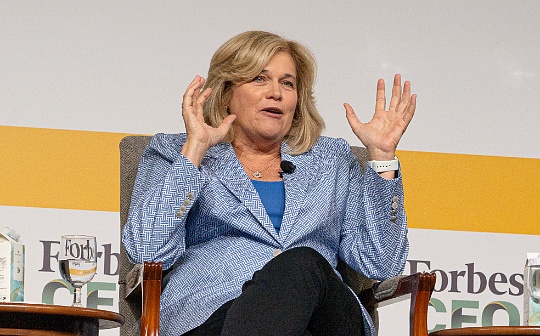HTX Ventures’ latest research report丨Encryption compliance opens the “new DeFi” era, RWAFi and stablecoin payments become new opportunities

Reprinted from panewslab
01/22/2025·3M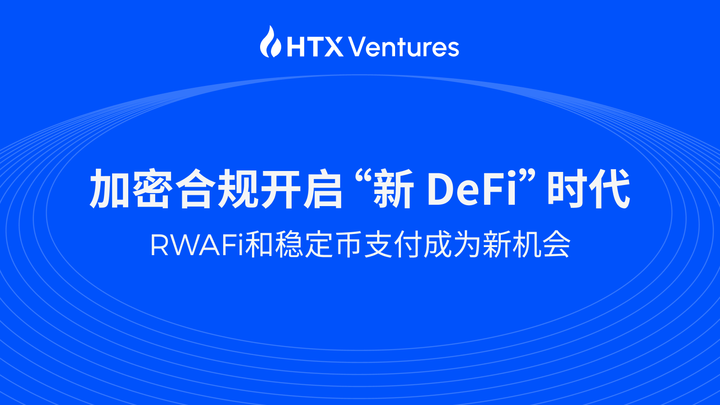
Since the DeFi Summer of 2020, AMMs (automated market makers), lending protocols, derivatives trading, and stablecoins have become core infrastructure in the crypto trading world. Over the past four years, many entrepreneurs have continued to iteratively innovate on these tracks, pushing projects such as Trader Joe and GMX to new heights. However, as these products gradually mature, the growth of the encryption trading track begins to hit the ceiling, and the birth of a new batch of top projects becomes increasingly difficult.
After the 2024 US election, the legalization and compliance process of the encryption industry is expected to bring new development opportunities to the industry. The integration of traditional finance and DeFi is accelerating: real assets (RWA) such as private credit, U.S. Treasury bonds, and commodities have gradually evolved from simple tokenized certificates in the early days into capital-efficient income-based stablecoins. It provides users with new choices and becomes a new growth engine for DeFi lending and trading. At the same time, stablecoins are playing an increasingly important strategic role in international trade, and the upstream and downstream infrastructure of the payment circuit continues to prosper. Traditional financial giants, including the Trump family, Stripe, PayPal and BlackRock, have accelerated their deployment to inject more possibilities into the industry.
After "old DeFi" such as Uniswap, Curve, dYdX and Aave, a new batch of unicorns in the crypto trading field are brewing. They will adapt to changes in the regulatory environment, use the integration of traditional finance and technological innovation to open up new markets and push the industry into the "new DeFi" era. For new entrants, this means that they no longer need to focus on micro-innovations in traditional DeFi, but focus on building breakthrough products that meet new environments and needs.
This article, written by HTX Ventures, will conduct an in-depth analysis around this trend, explore potential opportunities and development directions in the new round of changes in the crypto trading track, and provide inspiration and reference for industry participants.
Changes in the trading environment during this cycle
Stablecoins pass compliance and their adoption rate in cross-border
payments continues to increase
Maxine Waters and Chairman Patrick McHenry of the U.S. House of Representatives Financial Services Committee plan to introduce a stablecoin bill in the short term, marking a rare bipartisan consensus on stablecoin legislation in the United States. Both parties agreed that stablecoins can not only consolidate the U.S. dollar's status as the global reserve currency, but also become an important buyer of U.S. Treasury bonds, which contains huge economic potential. For example, Tether generated $6.3 billion in profits last year with just 125 employees, fully demonstrating its profitability.
This bill may become the first comprehensive cryptocurrency legislation to pass Congress in the United States, promoting widespread access to encrypted wallets, stable coins, and blockchain-based payment channels for traditional banks, businesses, and individuals. In the next few years, stable currency payments are expected to become popular, becoming another "step development" in the encryption market after Bitcoin ETFs.
Although compliant institutional investors cannot directly benefit from the appreciation of stablecoins, they can profit by investing in stablecoin-related infrastructure. For example, mainstream blockchains that support a large supply of stablecoins (such as Ethereum, Solana, etc.) and various DeFi applications that interact with stablecoins will benefit from the growth of stablecoins. Currently, stablecoins account for more than 50% of blockchain transactions, up from 3% in 2020. Its core value lies in seamless cross-border payments, a feature that is growing particularly rapidly in emerging markets. Taking Türkiye as an example, stablecoin trading volume accounts for 3.7% of its GDP; while in Argentina, the stablecoin premium is as high as 30.5%. Innovative payment platforms such as Zarpay and MentoLabs use local agents and payment systems to attract users into the blockchain ecosystem with grassroots market strategies, further promoting the popularity of stablecoins.
Currently, the size of the cross-border B2B payments market processed by traditional payment channels is approximately US$40 trillion, while the global consumer remittance market generates hundreds of billions of US dollars in revenue each year. Stablecoins provide this market with a new means of achieving efficient cross-border payments through encrypted channels. The adoption rate is increasing rapidly. It is expected to enter and subvert this part of the market and become an important force in the global payment landscape.
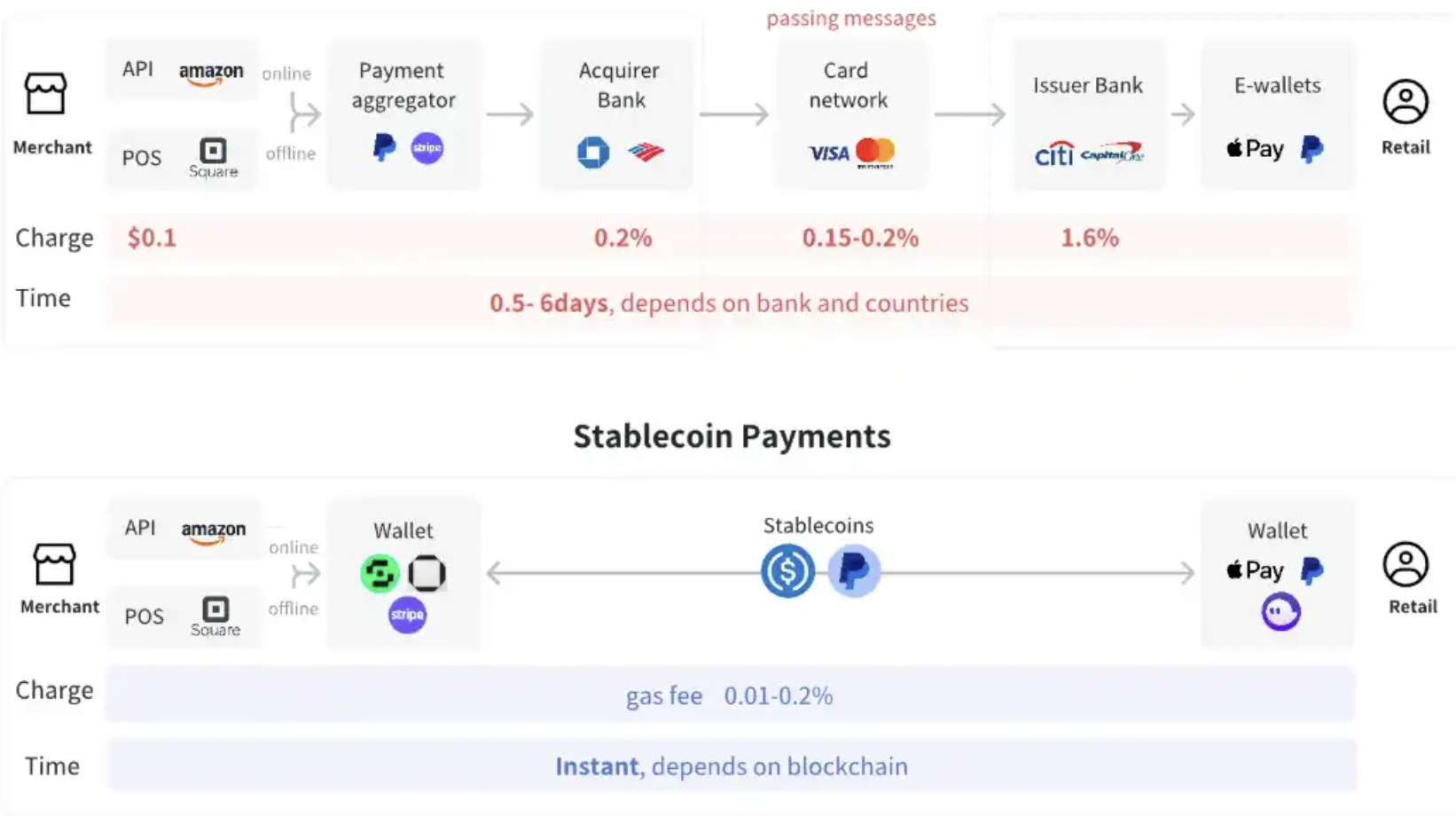
https://mirror.xyz/sevenxventures.eth/_ovqj0x0R_fVAKAKCVtYSePtKYv8YNLrDzAEwjXVRoU
The RLUSD stablecoin launched by Ripple is specially designed for corporate payments and aims to improve the efficiency, stability and transparency of cross-border payments to meet the needs of US dollar-denominated transactions. At the same time, Stripe acquired stablecoin platform Bridge for $1.1 billion, making this transaction the largest acquisition in the history of the cryptocurrency industry. Bridge provides enterprises with seamless conversion between fiat currencies and stablecoins, further promoting the application of stablecoins in global payments. Bridge's cross-border payment platform handles more than $5 billion in annual payment volume, and has provided global fund settlement for high-end customers including SpaceX, demonstrating the convenience and effectiveness of stablecoins in international transactions.
In addition, PEXX, as an innovative stablecoin cross-border payment platform, supports the exchange of USDT and USDC into 16 legal currencies and can remit funds directly to bank accounts. Through a streamlined onboarding process and instant conversion, PEXX enables users and businesses to make cross-border payments efficiently and cost-effectively, breaking down the barriers between traditional finance and cryptocurrencies. This innovation not only provides faster and more cost-effective cross-border payment solutions, but also promotes decentralization and seamless connection of global capital flows. Stablecoins are gradually becoming an important part of global payments, improving the efficiency and popularity of the payment system.
Regulation of perpetual contract trading expected to be relaxed
Since the high-leverage nature of perpetual contract transactions can easily lead to customer losses, regulatory agencies in various countries have always been quite strict on their compliance requirements. In many jurisdictions, including the United States, not only centralized exchanges (CEX) are prohibited from providing perpetual contract services, but decentralized perpetual contract exchanges (PerpDEX) cannot escape the same fate. This directly compresses the market space and user scale of PerpDEX.
However, with Trump’s victory in the election, the compliance process in the encryption industry is expected to accelerate, and PerpDEX is likely to usher in a spring of development. There are two landmark events worthy of attention recently: First, David Sacks, the encryption and AI consultant appointed by Trump, has invested in dYdX, a veteran player in this track; second, the U.S. Commodity Futures Trading Commission (CFTC) is expected to replace the U.S. Securities and Exchange Commission (SEC), becoming the primary regulator of the crypto industry. The CFTC has accumulated rich experience in the launch of CME Bitcoin futures trading, and has a more friendly regulatory attitude towards PerpDEX compared to the SEC. These positive signals may open new market opportunities for PerpDEX and create more favorable conditions for its growth under future compliance frameworks.
The value of RWA’s stable income is being discovered by crypto users
In the past, the high-risk and high-reward crypto market environment made the stable returns of RWA (real world assets) no one care about. However, in the past bear market cycle, the RWA market has grown against the trend, and its lock-in value (TVL) has jumped from less than one million US dollars to today's hundreds of billions of US dollars. Unlike other crypto assets, RWA’s value fluctuations are not driven by crypto market sentiment. This feature is crucial to shaping a robust DeFi ecosystem: RWA can not only effectively increase the diversification of investment portfolios, but also provide a solid foundation for various financial derivatives, thereby helping investors to hedge against violent market turmoil. risk.
According to data from RWA.xyz, as of December 14, RWA had 67,187 holders, the number of asset issuers reached 115, and the total market value reached US$139.9 billion. Web3 giants including Binance predict that the RWA market size is expected to expand to $16 trillion by 2030. This market structure with huge potential and the investment attraction brought by its stable income are gradually becoming an indispensable and important part of the DeFi ecosystem.

After the Sanjian Capital scandal, the crypto industry exposed a key problem: the lack of sustainable income scenarios for assets. As the Federal Reserve begins the process of raising interest rates, global market liquidity tightens, and cryptocurrencies, which are defined as high-risk assets, are particularly affected. In contrast, the yields on real-world assets (such as U.S. Treasuries) have risen steadily since the end of 2021, attracting market attention. From 2022 to 2023, the median return of DeFi dropped from 6% to 2%, which is lower than the 5% of the risk-free return of U.S. bonds during the same period, making high-net-worth investors lose interest in on-chain returns. As on-chain revenue dries up, the industry begins to turn to RWA, hoping to re-energize the market by introducing stable off-chain revenue.
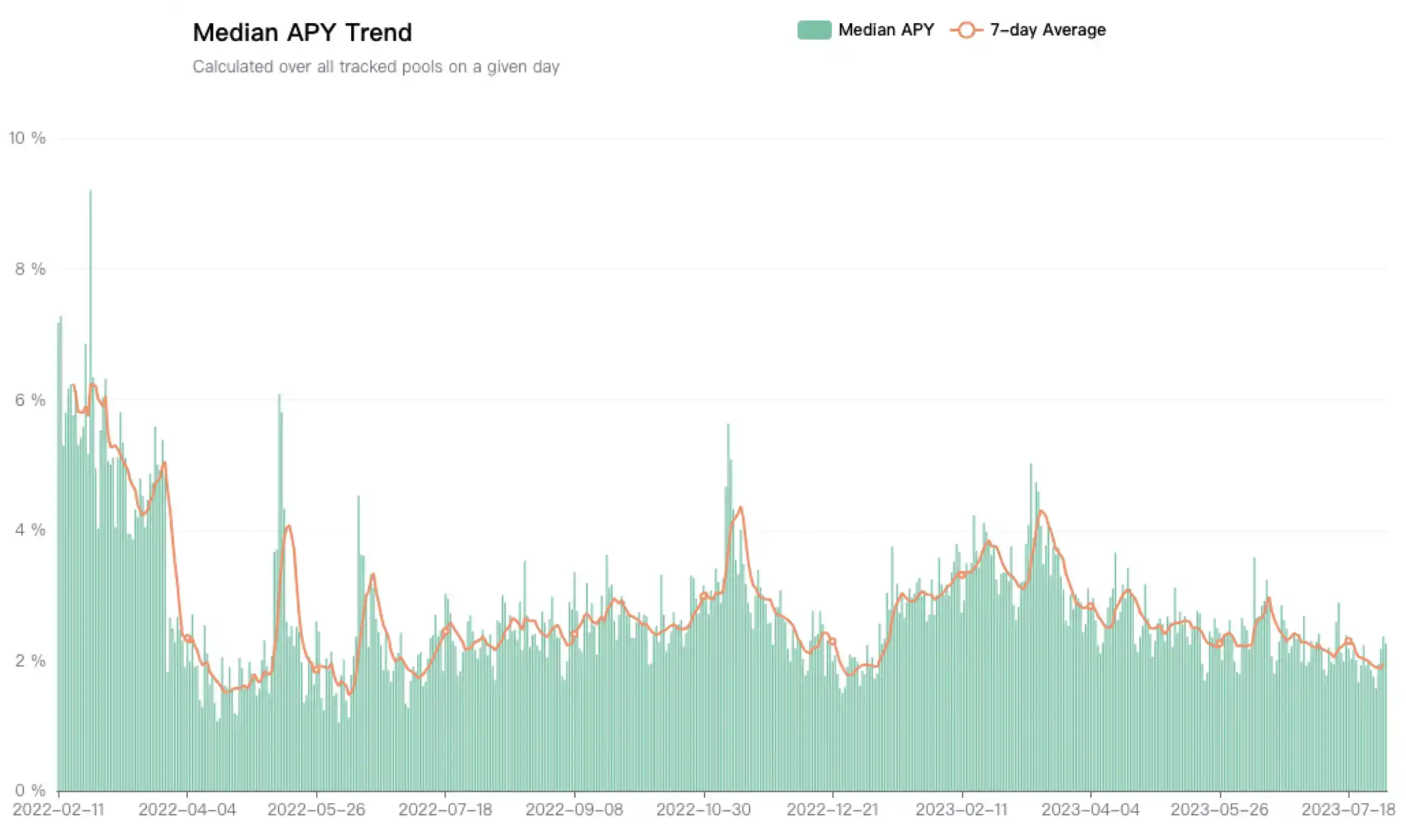
https://www.theblockbeats.info/news/54086
In August 2023, MakerDAO raised the DAI deposit interest rate DSR (DAI Savings Rate) to 8% in its lending protocol Spark Protocol, triggering the recovery of the long-dormant DeFi market. In just one week, the protocol's DSR deposits surged by nearly $1 billion, and the circulating supply of DAI also increased by $800 million, hitting a three-month high. The key factor driving this growth is RWA (Real World Assets). Data shows that in 2023, more than 80% of MakerDAO's fee income will come from RWA. Since May 2023, MakerDAO has increased its investment in RWA, purchasing U.S. Treasury bonds in bulk through entities such as Monetalis, Clydesdale and BlockTower, and deploying funds to RWA lending protocols such as Coinbase Prime and Centrifuge. As of July 2023, MakerDAO has a RWA investment portfolio of nearly $2.5 billion, of which more than $1 billion comes from U.S. Treasury bonds.
The successful exploration of MakerDAO triggered a new round of RWA craze. The DeFi ecosystem reacted quickly, driven by high returns on blue-chip stablecoins. For example, the Aave community proposed to list sDAI as collateral, further expanding the application of RWA in DeFi. Similarly, in June 2023, Superstate, a new company launched by the founder of Compound, focuses on introducing real-world assets such as bonds into the blockchain to provide users with stable income similar to the real world.
RWA has become an important bridge connecting real assets and on-chain finance. As more and more innovators explore the potential of RWA, the DeFi ecosystem has gradually found a new path to stable income and diversified development.
Licensed institutions go on-chain to expand market size
In March this year, BlackRock launched BUIDL, the first U.S. debt tokenized fund issued on a public blockchain, which attracted market attention. The fund provides qualified investors with the opportunity to earn income on U.S. debt and was first deployed on the Ethereum blockchain and later expanded to multiple blockchains such as Aptos, Optimism, Avalanche, Polygon and Arbitrum. Currently, $BUIDL has no practical utility as a token income certificate, but its landmark release has taken an important step towards tokenized finance.
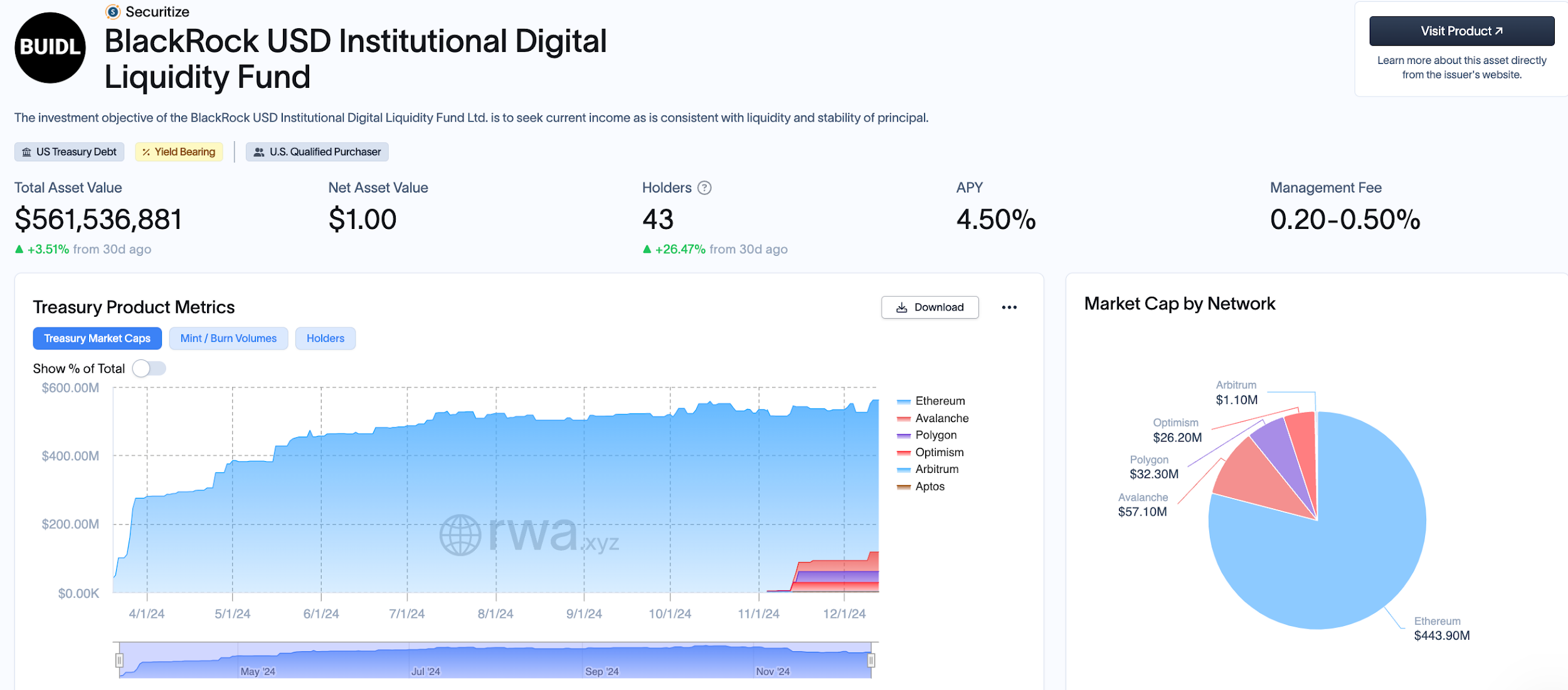
https://app.rwa.xyz/assets/BUIDL
At the same time, Wyoming Governor Mark Gordon announced that the state government plans to issue a stablecoin pegged to the U.S. dollar in 2025 and support it through U.S. Treasury bills and repurchase agreements. The stablecoin is expected to be launched in cooperation with the trading platform in the first quarter of 2025, marking that government-level stablecoin experiments will become a new highlight in the market.
In the traditional financial field, State Street, as one of the world's top asset management companies, is actively exploring various ways to integrate into the blockchain payment and settlement system. In addition to considering issuing its own stablecoin, State Street also plans to launch a deposit token that represents customer deposits on the blockchain. As the world's second largest fund custodian bank, State Street, which manages more than $4 trillion in assets, seeks to improve service efficiency through blockchain technology, marking positive progress in the digital transformation of traditional financial institutions.
JPMorgan Chase is also accelerating the expansion of its blockchain business and plans to launch on-chain foreign exchange functions in the first quarter of 2025 to achieve round-the-clock automated multi-currency settlement. Since launching the blockchain payment platform in 2020, JPMorgan Chase has completed more than US$1.5 trillion in transactions, involving areas such as intraday repurchases and cross-border payments. Platform users include large global companies such as Siemens, BlackRock, and Ant International. JPMorgan plans to expand its platform to support automated settlements in U.S. dollars and euros first, with more currencies to come in the future.
JPMorgan Chase’s JPM Coin is an important part of the bank’s blockchain strategy. As a digital dollar designed for institutional clients, JPM Coin provides instant payments and settlements around the world. Its launch has accelerated the process of putting digital assets on the blockchain for financial institutions and has taken the lead in cross-border payments and capital flows.
In addition, Tether's recently launched Hadron platform has also promoted the process of asset tokenization and aims to simplify the digital token conversion of multiple assets such as stocks, bonds, commodities, funds, etc. The platform provides tokenization, issuance, destruction and other services for institutions, funds, governments and private companies, and supports functions such as KYC compliance, capital market management and supervision, further promoting the digital transformation of the asset management industry.
RWA token issuance compliance tools emerge
Securitize is an innovative platform focused on fund issuance and investment on the blockchain. Its cooperation with BlackRock began with its deep involvement in the field of RWA (real world assets), and it provides professional services to many large asset securitization companies, including the issuance, management and trading of tokenized securities. Through Securitize, companies can issue bonds, stocks and other types of securities directly on the blockchain, and use the full set of compliance tools provided by the platform to ensure that the tokenized securities issued strictly comply with the legal and regulatory requirements of various countries.
Since obtaining registration as a transfer agent with the U.S. Securities and Exchange Commission (SEC) in 2019, Securitize has rapidly expanded its operations. In 2021, the company received $48 million in financing led by Blockchain Capital and Morgan Stanley. In September 2022, Securitize helped KKR, one of the largest investment management companies in the United States, tokenize some of its private equity funds and successfully deployed it on the Avalanche blockchain. The following year, also on Avalanche, Securitize issued equity tokens for Spanish real estate investment trust Mancipi Partners, becoming the first company to issue and trade tokenized securities under the EU's new digital asset pilot system.
Recently, Ethena, the leading stablecoin issuer, announced its cooperation with Securitize to launch a new stablecoin product USDtb. The stablecoin’s reserve funds are invested in BlackRock’s USD Institutional Digital Liquidity Fund (BUIDL), further solidifying Securitize’s position in the blockchain financial ecosystem.
In May 2023, Securitize once again received US$47 million in strategic financing led by BlackRock, which will be used to accelerate the expansion of partnerships with partners in the financial services ecosystem. As part of the financing, Joseph Chalom, BlackRock's head of global strategic ecosystem partnerships, was appointed to Securitize's board of directors. This cooperation marks Securitize’s further deepening of the integration of traditional finance and blockchain technology.
opportunities and challenges
Private credit RWA enters the Payfi era, how to solve the default
problem
Private credit currently totals approximately $13.5 billion, with an active loan value of $8.66 billion, and the current average annual interest rate is 9.46%. Private credit remains the second largest asset class in the RWA (real world assets) market, with approximately 66% of issuance provided by Figure Markets.
Figure Markets is a trading platform built on the Provenance blockchain, covering a variety of asset types such as stocks, bonds and real estate. The platform received more than US$60 million in Series A investment from Jump Crypto, Pantera Capital and other institutions in March this year. The current TVL (total value locked) has reached US$13 billion, making it the platform with the highest TVL in the RWA market. Different from traditional non-standard private credit RWA, Figure Markets mainly focuses on the standardized market of real estate loans (HomeLoan), which gives it a large market size and growth potential, and there will be more opportunities in the future.

https://app.rwa.xyz/?ref=ournetwork.ghost.io
In addition, private credit also includes corporate institutional loans. The main projects that emerged in the last cycle are Centrifuge, Maple Finance and Goldfinch.
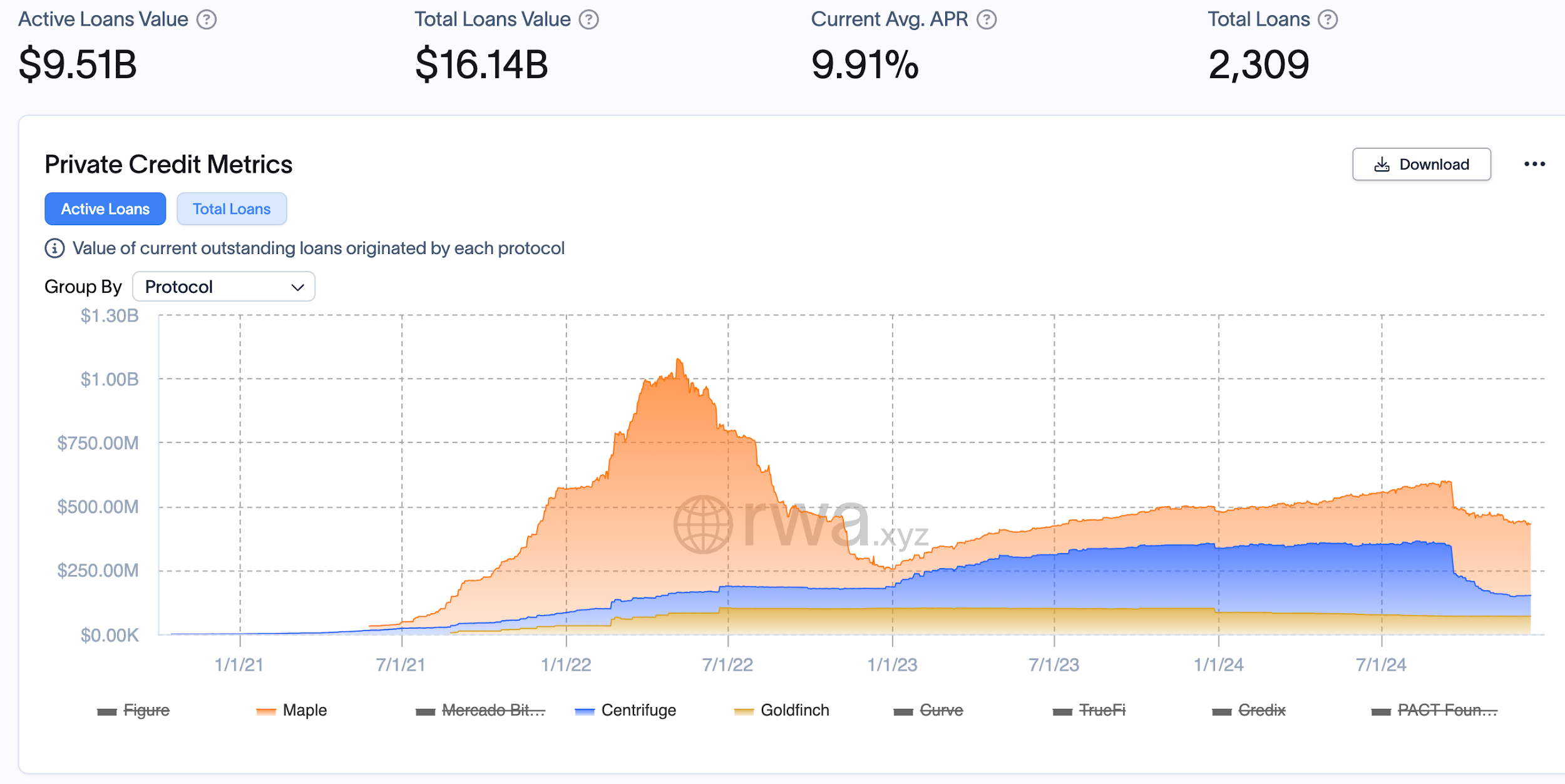
TVL has rebounded this year https://app.rwa.xyz/?ref=ournetwork.ghost.io
- Centrifuge is a decentralized asset financing protocol that tokenizes real-world assets (such as real estate, bills, invoices, etc.) into NFTs through its Tinlake protocol, which can be used as collateral for borrowers. Borrowers can obtain liquidity in decentralized capital pools through these NFTs, and investors provide funds through these capital pools and receive fixed returns. Centrifuge's core innovation is to combine blockchain with traditional financial markets to help enterprises and startups obtain financing at a lower cost, and reduce credit risks and intermediary costs through the transparency and decentralization provided by blockchain.
However, Centrifuge is also subject to risks arising from market fluctuations. Although its asset tokenization model is favored by many traditional financial institutions, in the case of large market volatility, borrowers may not be able to repay on time, leading to default events. For example, some assets with high market volatility may not be able to fulfill their loan contracts, especially in the bear market stage when liquidity is insufficient, which puts the borrower's repayment ability to a greater test.
- Maple Finance specializes in high-yield secured loans to corporate and institutional borrowers. The loan pool on the platform is usually over-collateralized by crypto assets such as BTC, ETH, and SOL. Maple uses an on-chain credit scoring mechanism that allows institutional borrowers to provide stable income to lenders by creating and managing loan pools. This model is particularly suitable for institutions within the crypto industry, reducing risk and increasing capital returns by providing over-collateralized loans to these institutions.
However, the Maple platform also faces severe tests in the bear market. Several major breaches have occurred one after another, especially as the overall crypto market is declining. Taking Orthogonal Trading as an example, it failed to repay a US$36 million loan on Maple Finance, which brought obvious default pressure to the platform.
- Goldfinch is a platform focused on on-chain credit lending, aiming to provide loans to start-ups and small and micro enterprises that cannot obtain financing through traditional channels. Unlike other RWA lending platforms, Goldfinch adopts an unsecured loan model and relies on borrowers' credit records and third-party assessment agencies to judge their repayment ability. Through capital pools, Goldfinch lends funds to borrowers in need and provides fixed returns to capital providers.
Goldfinch's problem mainly lies in the choice of borrowers. Many borrowing companies face higher default risks, especially start-ups and small and micro enterprises from high-risk markets. For example, in April 2022, Goldfinch suffered a $10 million loan default, with the main losses coming from higher-risk small and micro businesses and startups. Although Goldfinch received investment from a16z, these defaults still revealed its shortcomings in risk control and market demand.
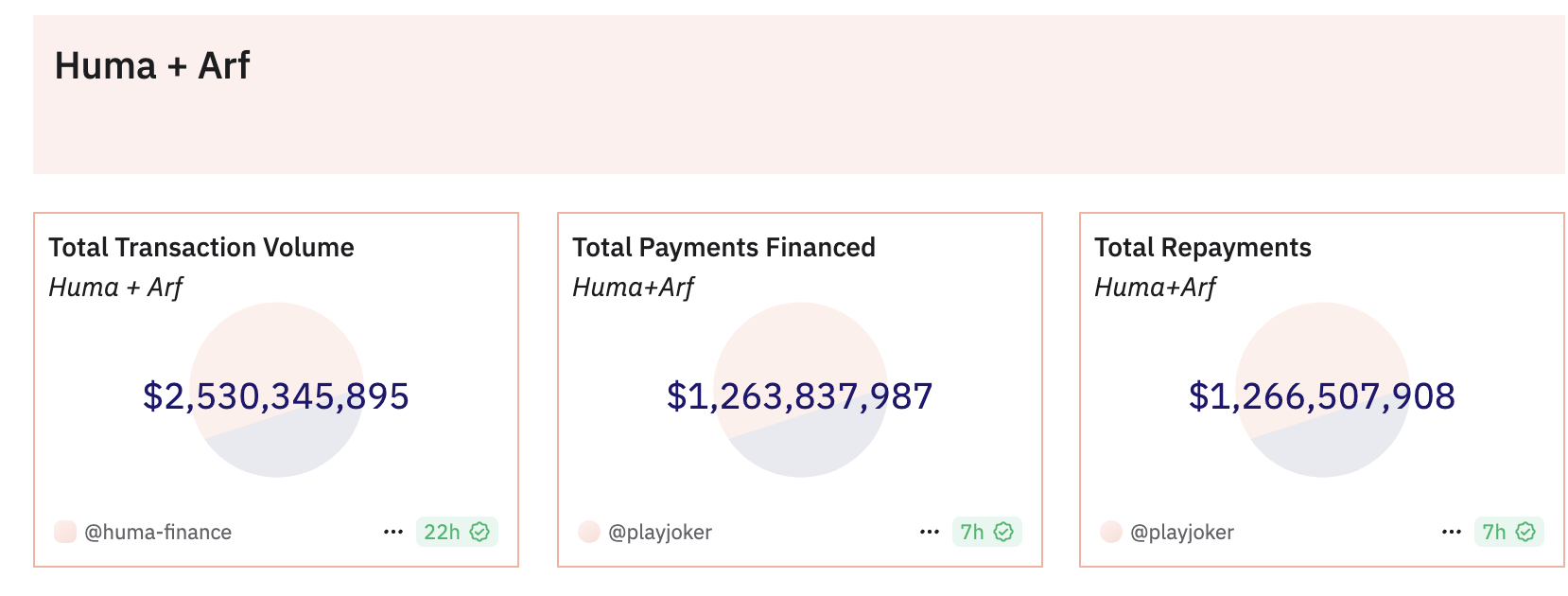
https://dune.com/huma-finance/huma-overview
The "Payfi" concept recently proposed by Solana has certain similarities in business logic with the private credit field, and has further expanded its application scenarios to diversified scenarios such as cross-border financing, lending, and cross-border payment swaps. Taking Huma Finance as an example, the platform focuses on providing financial services to investors and borrowers. Investors earn income by providing funds, and borrowers can borrow and repay. At the same time, Huma's subsidiary Arf focuses on cross-border payment advance services, greatly optimizing the traditional cross-border remittance process.
For example, when sending money from Singapore or Hong Kong to South Africa, traditional Swift money transfer methods are often time-consuming and costly. Although many people choose companies such as Western Union, these remittance companies need to cooperate with local partners in South Africa and rely on huge local advances to complete same-day settlement. This model brings a huge burden to remittance companies, because they need to process advances in different legal currencies in multiple countries around the world, and efficiency is difficult to guarantee. Arf abstracts the advance service by introducing stablecoin to provide payment companies with fast capital flow support.
For example, when a user transfers $1 million to South Africa, Arf ensures that the funds enter a regulated account and completes cross-border settlement through stablecoins. Huma conducts due diligence on payment companies before settlement to ensure security. Throughout the entire process, Huma lends and withdraws stablecoins, without the need to intervene in the deposit and withdrawal operations of legal currency, thus achieving fast, safe and efficient capital flow.
Huma's main customers come from developed countries such as the United Kingdom, the United States, France and Singapore. The bad debt rates in these areas are extremely low, the account period is usually 1 to 3 days, charges are charged on a daily basis, and the capital chain is transparent and efficient. Currently, Huma has achieved a capital flow of US$2 billion and a bad debt rate of 0%. Through its partnership with Arf, Huma has achieved substantial double-digit gains that are token-agnostic.
In addition, Huma plans to further integrate into DeFi projects, such as Pendle, and explore token point reward mechanisms and broader decentralized financial gameplay to further enhance user benefits and market appeal. Huma’s model could be an innovative way to address private credit defaults.
How will the leader of income-based stablecoins belong?
This cycle may see the emergence of stablecoins that are as safe as USDT/USDC and can provide at least 5% sustainable returns. This market undoubtedly contains huge potential. Currently, USDT issuer Tether's annual profits are close to tens of billions of dollars, and its team only has about 100 people. If this part of the profits can be returned to users, can the vision of a revenue-based stable currency be realized?
The underlying gameplay of national debt
Currently, stablecoins built with treasury bonds as underlying assets are becoming a new trend in the crypto market. These stablecoins introduce traditional financial assets into the blockchain through tokenization, which not only retains the stability and low-risk characteristics of government bonds, but also provides the high liquidity and composability of DeFi. They use a variety of strategies to increase risk premiums, including fixed budget incentives, user fees, volatility arbitrage, and leveraging reserves such as staking or re-hypothecation.
USDY launched by Ondo Finance is a typical example of this trend. USDY is a tokenized note guaranteed by short-term U.S. Treasury bonds and bank demand deposits. Its structure is designed to comply with U.S. laws and regulations. It can be used as collateral in DeFi protocols and as a transaction medium for Web3 payments. USDY is divided into two types: accumulation type (USDY) and rebased type (rUSDY). The former is suitable for long-term holding, while the latter realizes profits by increasing the number of tokens and is suitable for use as a settlement tool. At the same time, the OUSG token launched by Ondo Finance focuses on providing highly liquid investment opportunities linked to U.S. short-term Treasury bonds. Its underlying assets are deposited in the BlackRock USD Institutional Fund and support instant minting and redemption.
In addition, OpenTrade provides a variety of Vault products based on Treasury bonds, including fixed-income U.S. Treasury Bill Vault and flexible-income USDC Vault, to meet the asset management needs of different users. OpenTrade deeply integrates its tokenized products with DeFi to provide holders with a seamless deposit and earning experience.
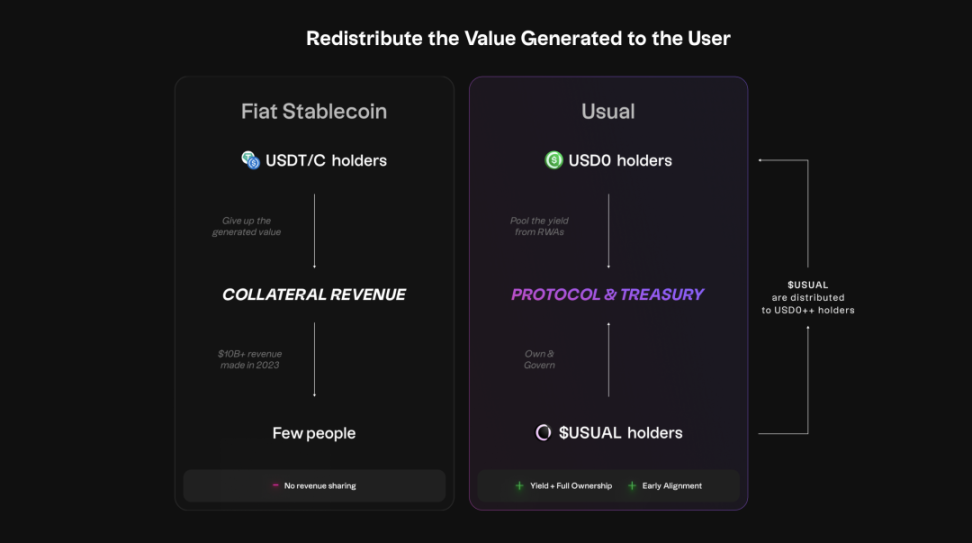
Comparison of USDT issuer income distribution and usual income distribution https://docs.usual.money/
The stablecoin USD0 launched by Usual Protocol provides two casting methods by tokenizing traditional financial assets such as U.S. Treasury bonds: users can directly mint USD0 by directly depositing RWA assets or indirectly minting USDC/USDT. USD0 is upgraded to USD0++ with higher returns, and provides users with additional loyalty rewards through cooperation with DeFi platforms such as Pendle.
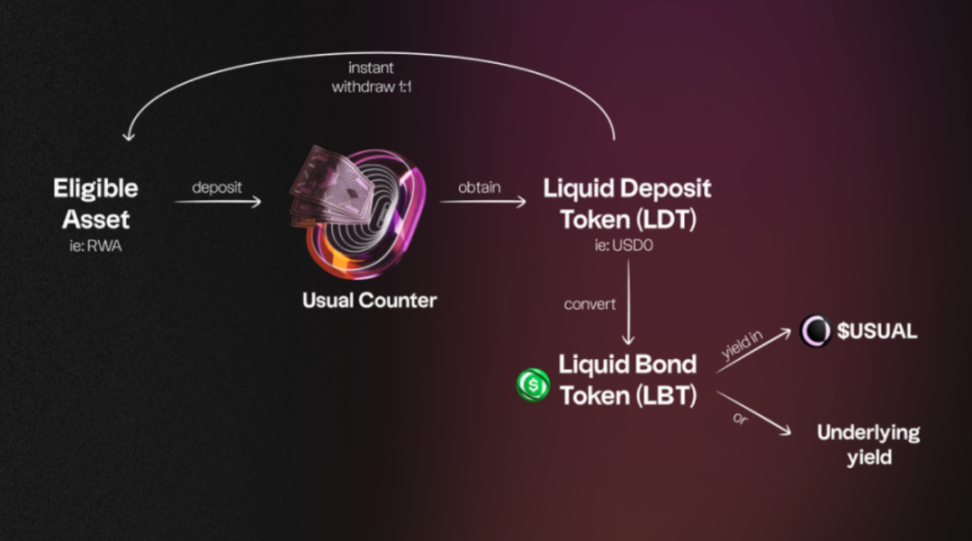
The sUSD stablecoin launched by Solayer on the Solana blockchain uses U.S. Treasury bonds as collateral, providing holders with an on-chain income of 4.33%, and supports being used as a pledged asset to enhance the stability and security of the Solana network. Through these mechanisms, the two not only improve the profitability of stablecoins, but also enhance the stability and efficiency of the DeFi ecosystem, demonstrating the huge potential of the integration of traditional finance and blockchain technology.
Low-risk on-chain arbitrage
In addition to the design with treasury bonds as the bottom layer, another income-based stable currency uses the fluctuations of the crypto market, MEV and other characteristics to perform arbitrage to obtain low-risk returns.
Ethena is the fastest-growing non-currency-backed stablecoin project since the collapse of Terra Luna. Its native stablecoin USDe surpasses Dai to temporarily rank third in the market with a volume of US$5.5 billion. The core design of Ethena is based on the Delta Hedging strategy of Ethereum and Bitcoin collateral. It hedges the impact of collateral price fluctuations on the value of USDe by opening a short position on CEX that is equal to the value of the collateral. This hedging mechanism relies on over-the-counter settlement service providers, and the protocol assets are hosted on multiple external entities. It aims to maintain the stability of USDe through the complementary rise and fall between the value of the collateral and the short position.
Project income mainly comes from three aspects: Ethereum pledge income generated by users staking LST; funding rate or basis income generated from hedging transactions; and Liquid Stables fixed rewards, that is, depositing USDC or other stable coins on Coinbase or other exchanges Interest earned on deposits. In essence, USDe is a packaged CEX low-risk quantitative hedging strategy financial product that can provide a floating annualized rate of return of up to 27% when market conditions are good and liquidity is sufficient.
Ethena's risks mainly come from the potential thunderstorms between CEX and the custodian, as well as the price decoupling and systemic risks that may be caused by insufficient counterparties during a run. During the bear market, when funding interest rates may remain low, the risks will be further intensified. This year, During the period of market volatility in the middle of the year, the protocol yield became negative -3.3%, but no systemic risk occurred.
Despite this, Ethena provides an innovative design logic for integrating on-chain and CEX, providing scarce short liquidity to the exchange by introducing a large number of LST assets brought by the main network merger, and at the same time bringing it fee income and market vitality. In the future, with the rise of order book DEX and the maturity of chain abstraction technology, there may be an opportunity to implement a fully decentralized stablecoin based on this idea.
At the same time, other projects are also exploring different income-based stablecoin strategies. For example, CapLabs achieves income by introducing MEV and arbitrage profit models, while Reservoir uses a diversified high-yield asset basket strategy to optimize asset allocation. DWF Labs will soon launch Falcon Finance, a revenue-generating synthetic stablecoin, includes two versions: USDf and USDwf.
These innovations have brought diverse choices to the stablecoin market and promoted the further development of DeFi.
RWA assets and DEFI applications help each other
RWA assets improve DEFI application stability
The reserve funds of Ethena's recently issued stablecoin USDtb are mainly invested in BlackRock's U.S. debt tokenization fund BUIDL, of which BUIDL accounts for 90% of the total reserves, which is the highest BUIDL allocation among all stablecoins. This design enables USDtb to effectively support the stability of USDe in difficult market environments, especially during periods when funding interest rates are negative. Ethena's risk committee approved a proposal last week to use USDtb as a backing asset for USDe, so that when the market is uncertain, Ethena can close USDe's underlying hedging position and reallocate the backing assets to USDtb, further mitigating market risks.
In addition, CDP stablecoins (such as Collateralized Debt Positions) also have improved staking and liquidation mechanisms through the introduction of RWA assets to increase peg stability. In the past, CDP stablecoins primarily used cryptocurrencies as collateral but faced scalability and volatility issues. In 2024, CDP stablecoins have enhanced risk resistance by accepting more liquid and stable collateral, such as Curve’s crvUSD, which recently added USDM (physical assets). Some liquidation mechanisms have also been improved, especially the soft liquidation mechanism of crvUSD, which provides a buffer for further bad debts and effectively reduces risks.
DEFI mechanism improves RWA token asset utilization efficiency
The new "RWA" partition launched by Pendle currently has a TVL of related assets of US$150 million, covering a variety of income-generating assets, including USDS, sUSDS, SyrupUSDC and USD0++.
Among them, USDS is similar to DAI, and users can receive SKY token rewards after depositing it into the SKY protocol; sUSDS is similar to sDAI, and part of its income comes from MakerDAO's treasury bond investment; SyrupUSDC is an income asset supported by the Maple digital asset loan platform. Income is generated by providing fixed interest rates and over-collateralized loans to institutional borrowers; while the income of USD0++ comes entirely from treasury bonds backed by 1:1, ensuring a stable rate of return.
Currently, the annualized rate of return provided by Pendle is quite attractive, of which sUSDS LP is as high as 432.4%, SyrupUSDC LP is 98.88%, USD0++ LP is 43.25%, and USDS LP is 22.96%. The high returns attract users to join in purchasing RWA stablecoins.
Syrup, a project launched by Maple in May this year, also relied on DeFi gameplay to achieve rapid growth, helping Maple regain a new lease of life after experiencing loan defaults in the bear market.
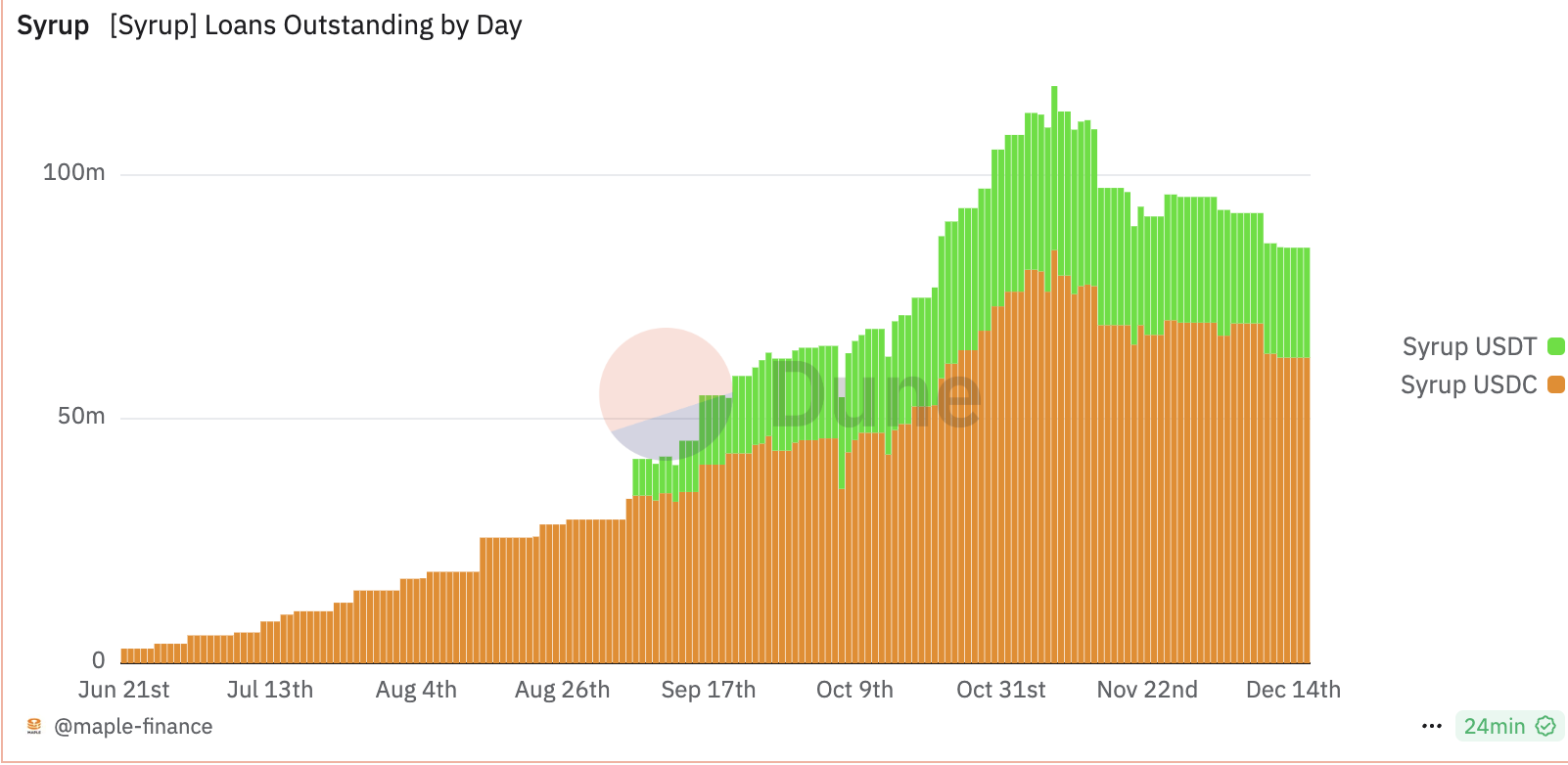
https://dune.com/maple-finance/maple-finance
In addition, if you purchase YT assets of USD0++ on Pendle, you can also get the usual airdrop, giving the U.S. debt on the chain more potential profit space through token gameplay.
Can the RWAFI public chain empower institutional finance?
Plume is a Layer 2 ecosystem focused on RWA, committed to integrating traditional finance (TradFi) and decentralized finance (DeFi) to create a financial ecological network covering more than 180 projects, and through the Enterprise Ethereum Alliance (EEA) and The Tokenized Asset Alliance (TAC) has established strategic alliances with institutions such as WisdomTree, Arbitrum, JPMorgan Chase, a16z, Galaxy Digital and Centrifuge to promote the implementation of industry standards and institutional-level RWAfi solutions.
Plume adopts a modular, permissionless compliance architecture that enables KYC and AML to be configured autonomously at the application level, embeds anti-money laundering (AML) protocols and works with blockchain analytics providers to ensure global security compliance while working with regulated Cooperate with brokers/dealers and transfer agents to ensure compliant issuance and trading of securities in the United States and other markets. The platform introduces Zero Knowledge Proof of Reserve (ZK PoR) technology to verify asset reserves while protecting privacy, supports global securities exemption standards such as Regulation A, D and S, and serves retail and institutional investors in multiple jurisdictions.
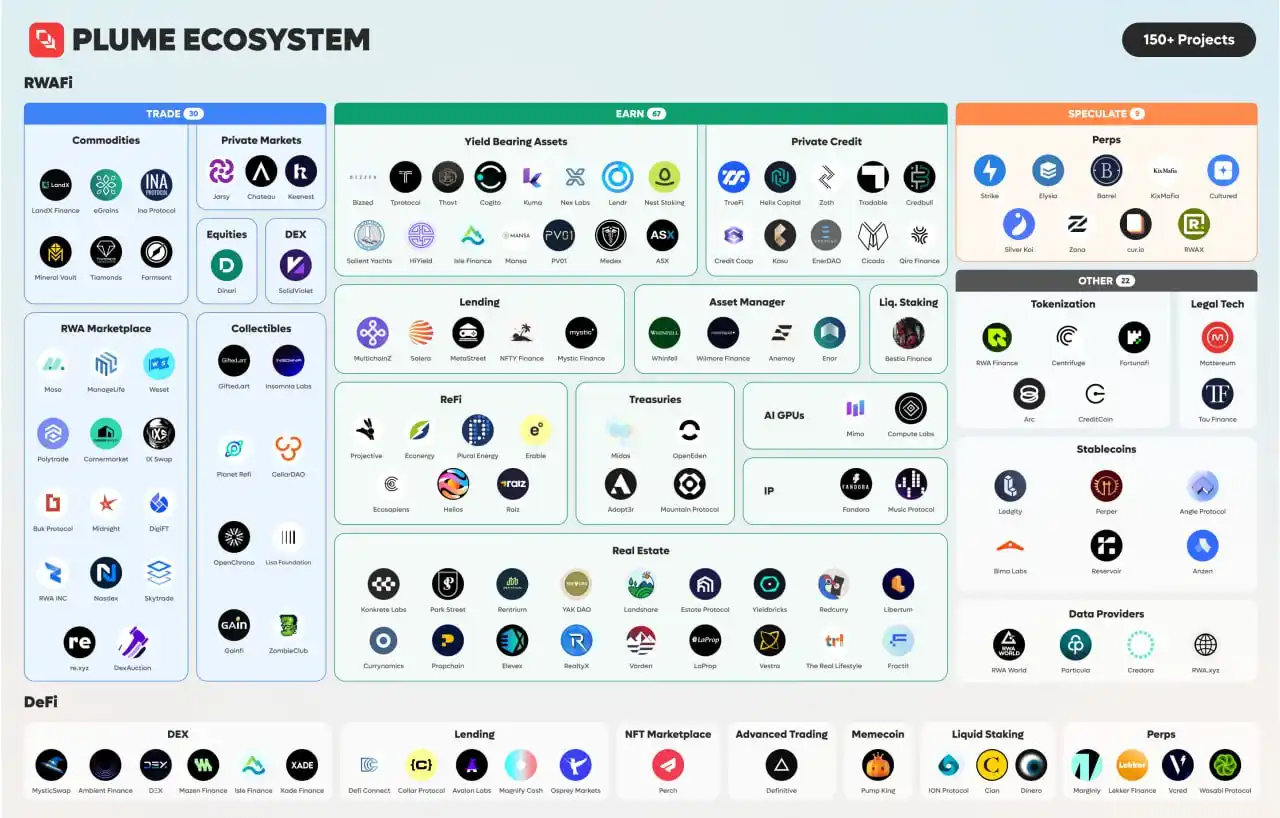
Functionally, Plume supports users:
- Use tokenized RWA (such as real estate, private credit) as collateral to borrow stablecoins or crypto-assets, providing low-volatility collateral to ensure security;
- Introducing liquidity staking, users can pledge assets to obtain liquidity tokens to participate in other DeFi protocols and increase compound income; the platform provides compound income assets, such as private credit and infrastructure investment, to generate stable returns and help reinvest income;
- Support RWA to be listed and traded on the Perpetual DEX. Users can go long/short real estate or commodities and other assets to achieve the combination of TradFi and DeFi transactions;
- In addition, Plume provides stable income assets of 7-15% annualized, covering areas such as private credit, solar energy and mining, attracting long-term investors; in terms of speculative assets, Cultured provides on-chain speculation opportunities based on data such as sports events and economic indicators. , to meet users’ needs for short-term high-yield transactions.
Avalanche is the first L1 public chain to fully embrace RWA. It has been exploring enterprise-level applications frequently since the end of 2022. With its unique subnet architecture, it helps organizations deploy custom blockchains optimized for specific use cases and achieve integration with Avalanche. Seamless interoperability of networks with unrestricted scalability. From the end of 2022 to the beginning of 2023, entertainment giants from South Korea, Japan and India successively built subnets on Avalanche. Avalanche has also keenly observed Hong Kong's trends in the field of asset tokenization. In April 2023, it launched the Evergreen subnet at the Hong Kong Web3.0 Summit to provide financial institutions with specialized blockchain deployment tools and services to support the development of private chains. It conducts blockchain settlement with licensed counterparties and maintains interoperability through the Avalanche local communication protocol (AWM), attracting institutions such as WisdomTree and Cumberland to join the test network Spruce.
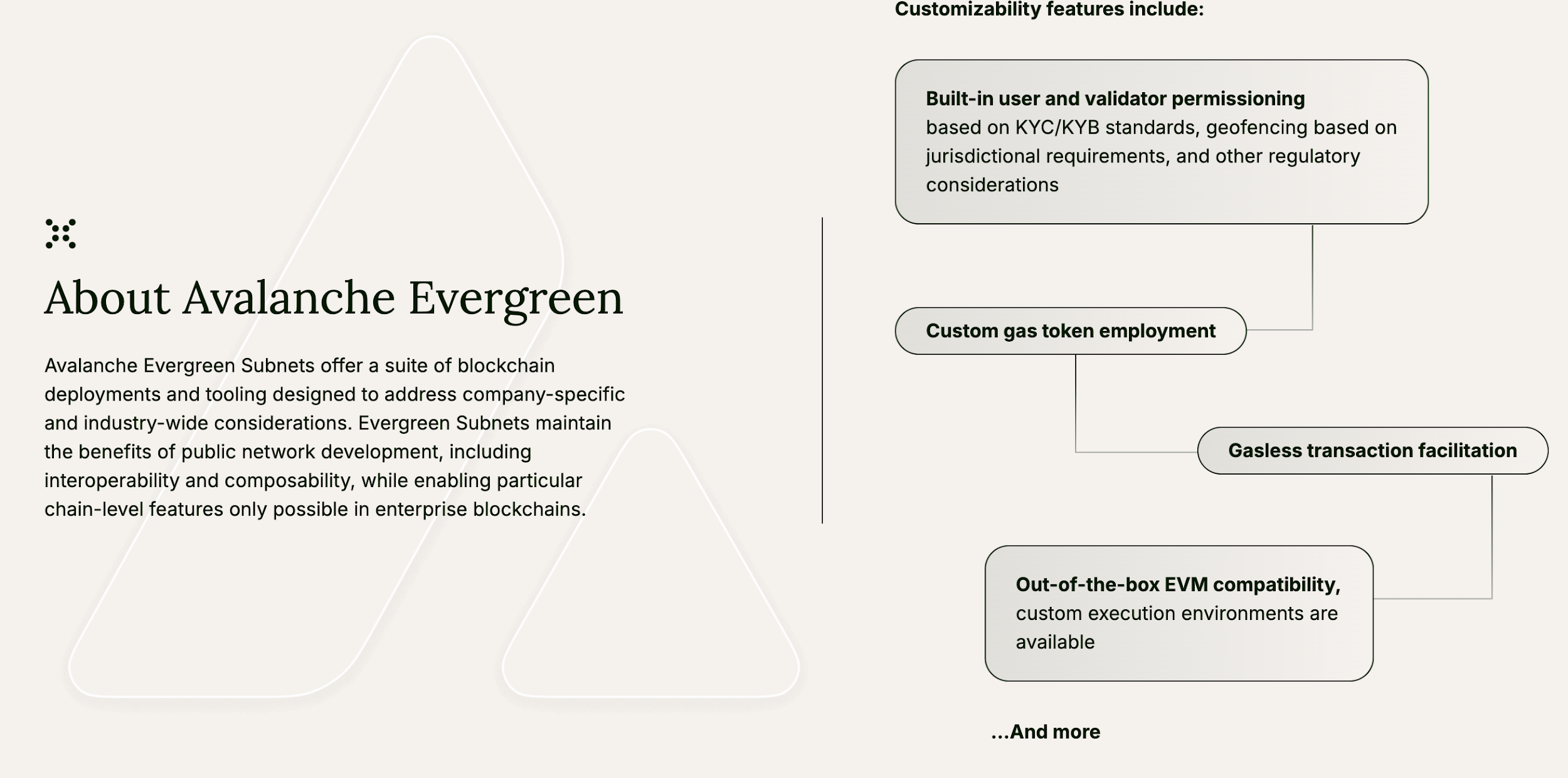
https://www.avax.network/evergreen
In November of the same year, Avalanche cooperated with JPMorgan Chase's Onyx platform, using LayerZero to connect Onyx and Evergreen, and promoted WisdomTree Prime to provide subscription and redemption of tokenized assets. The cooperation was included in the "Guardian Plan" of the Monetary Authority of Singapore (MAS) . Subsequently, Avalanche continued to expand institutional cooperation. In November, it helped the financial service company Republic to launch a token -based investment fund Republic Note. In February 2024, it conducted a tokenization test of private equity funds with Citi Bank, Wisdomtree and other institutions on the SPRUCE test network. 3 Moon and Australia and New Bank cooperated with ChainLink to settle in the asset settlement between Avalanche and Ethereum through CCIP, and it was integrated with the payment giant Stripe in April.
In addition, the Ecological Internal Foundation has also actively promoted the development of RWA, launched the Avalanche Vista program, invested $ 50 million to purchase bonds, real estate and other token assets, and invested in BALCONY, RE and other RWA projects through Blizzard Fund. John Wu, executive president of Ava Labs, said that Avalanche's mission is to "present the world's assets on the chain". Through the advantages of blockchain such as instant settlement, the strong regulatory entities of traditional finance are brought into the space of the chain. The agency realizes the best choice for the chain.
New direction worth looking forward to
Chain foreign exchange
Traditional foreign exchange systems are inefficient and faces many challenges, including risk of settlement of opponents (although the CLS has improved security, but the process is still cumbersome), the cost of multi -banking system coordination (such as the coordination of six banks to buy yen in the Australian bank), the world Differences in settlement time zone (such as the overlap time of the Canadian dollar and the yen banking system is less than 5 hours per day), and the access restrictions on the foreign exchange market (the fee paid by retail users is 100 times that of large institutions). ON-Chain FX provides real-time price quotes through real-time prediction machines (such as Redstone and Chainlink), and uses the decentralized exchange (DEX) to achieve cost benefits and transparency. For example, the CLMM of Uniswap reduced transaction costs to 0.15 %-0.25%, which is about 90%lower than traditional foreign exchange. Instant settlement on the chain (replacing traditional T+2 settlement) also provides more opportunities for arbitrage to correct market pricing errors. In addition, the foreign exchange on the chain simplifies the financial management of the enterprise, so that it can access multiple products without multiple dedicated bank accounts. Retail users can obtain the optimal exchange rate by wallets embedded in the DEX API. In addition, foreign exchange on the chain realizes the separation of currency and judicial regions, and gets rid of the dependence on the domestic banks. Although there are advantages and disadvantages of this method, it effectively uses digital efficiency and maintains currency sovereignty.
However, foreign exchange on the chain still faces challenges such as scarcity of non -US dollar digital assets, predictive machine safety, long -tail currency support, regulatory issues, and unified entry and exit chains. Nevertheless, its potential is huge, and Citi Bank is developing a blockchain -based foreign exchange solution under the guidance of the Singapore Financial Administration (MAS). The daily transaction volume of the foreign exchange market exceeds 7.5 trillion US dollars, especially in the south of the world. Individuals often exchange US dollars through the black market to obtain a more favorable exchange rate. Although the Binance P2P provides options, due to the insufficient flexibility of the order book mode, the project such as VIFI is developing a chain -based automated market (AMM) foreign exchange solution, bringing new possibilities to the foreign exchange market on the chain.
Cross -border payment stack
Cryptocurrencies have long been regarded as a key tool for solving the trillion US dollar cross -border payment market, especially in the global remittance market, and create hundreds of billions of dollars each year. Stable coins now provide new paths for cross -border payment, mainly including three levels: merchant layers, stable coins integration and foreign exchange liquidity. In the merchant layer, by launching applications and interfaces for retail or commercial transactions, merchants can establish stable currency flow, form a moat, and then add other services, control user experience, and achieve end -to -end customers cover. . The stable currency integration layer provides access channels, virtual accounts, cross -border stable currency transfer, and exchange of stable currency with legal currency. The license will become the core competitiveness, which can ensure the lowest cost and maximum global coverage. Construction. The foreign exchange and liquidity layer is responsible for the efficient exchange of stable currency and US dollar, legal currency or regional stable currency. In addition, as the encrypted exchanges are constantly emerging to cater to participants in various places, cross -border stable currency payment applications and processors facing specific markets will gradually rise.
Similar to the traditional finance and payment system, building defensive and scalable moats is the key to maximizing business opportunities at all levels. Over time, the various layers of the stack will gradually integrate, and the most aggregated potential of the merchant layer can be packaged to the users to provide users, further increase value, increase the source of profit, and control foreign exchange transactions, entry -exit channel selection and stable currency issuance Commercial cooperation to build a comprehensive and efficient cross -border payment solution.
The stable currency aggregation platform of the multi -pool model
In a world with stable currency in most companies, the problem of fragmentation of stable currency funds is becoming increasingly serious. Although the traditional entry and exit solutions can provide short -term relief, it has failed to achieve the efficiency promised by cryptocurrencies. To solve this problem, Numéraire on Solana introduced USD*, providing a high -efficiency and flexible multi -asset stable currency exchange platform for the Solana ecosystem, specifically cope with the challenge of stable currency fragmentation.
The platform realizes seamless creation and exchange between different stable currencies through the AMM mechanism. All stable coins share the same liquidity pool, avoiding the decentralization of funds, thereby significantly improving capital efficiency and liquidity management. As the core element of the system, USD acts as the intermediate unit, simplifies the exchange process between stable currency, promotes more accurate price discovery, and reflects the market's valuation of various stable coins in real time. Users can not only cast stablecoins through protocols, but also use stratified mortgage debt position system to customize risk returns to further improve the utilization rate of funds. At the same time, the loan function enables the excess stablecoin to be used in efficiently in the system and optimizes capital operation.
Although Numéraire still has a gap with platforms such as Raydium in terms of liquidity. Its innovative design targets more forward -looking solutions for the fragmented problem of stable currency ecology, which can more effectively meet the needs of institutional needs and the actual world of stable currency flow. Real needs of sex.
Looking back at the previous round of market cycle, the stable currency products using multiple pools models have achieved successful landing on CURVE on Ethereum. This model is well received due to its efficiency in stable currency exchange. Looking forward to the future, with the continuous expansion of the scale of stable currency issuance on other public chains, similar multi -pool model products are expected to gradually appear in more blockchain ecology, thereby further promoting the scale and mature development of the stabilized currency market.
Reference content:
https://foreSightnews.pro/article/detail/73859
https://app.rwa.xyz/?ref=ourNetwork.it.
https://mirror.xyz/sevenVENTUR
https://www.theblockbeats.info/news/54086
https://cryptoslate.com/the-8-sxt-big-trends-in-defi/
https://medium.com/ybbcapital/the-strategic-battleGround- StableCoins-AB516EE66F66
About HTX Ventures
HTX Ventures is the global investment department of Huobi HTX. It integrates investment, incubation and research, and identifies the world's best and smartest teams. As a pioneer in the industry, HTX Ventures has a history of more than ten years and is good at identifying cutting -edge technology and emerging business models in this field. In order to promote growth in the blockchain ecosystem, we provide comprehensive support for the project, including financing, resources and strategic suggestions.
HTX Ventures currently supports more than 300 projects, covering multiple blockchain fields, and some high -quality projects have traded on Huobi HTX exchange. In addition, as one of the most active FOF funds, HTX Ventures has invested in 30 top funds around the world and has cooperated with Polychain, Dragonfly, Bankless, Gitcoin, Figment, Nomad, Animoca and Hack VC to jointly create to jointly create Blockchain ecosystem.
Website: https://www.htx.com/ventures
Twitter: https://x.com/ventures_htx
Medium: https://htxventures.medium.com/

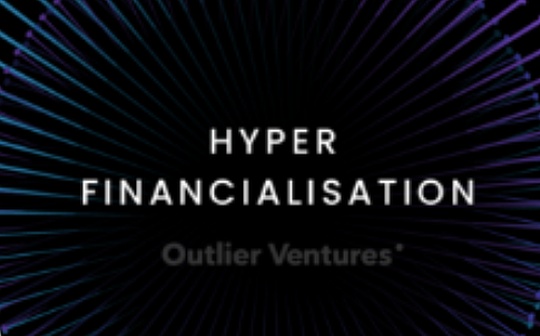
 jinse
jinse